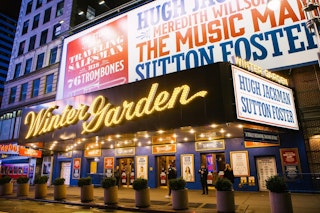
Since the 1940s and the Golden Age of Broadway, thousands of plays and musicals have graced the stages of the Great White Way. Ask any Broadway superfan, and they’ll happily wax lyrical about their favourite shows from every decade. However, only a tiny proportion of these shows have transcended the debate and are considered objective Broadway classics, adored by millions worldwide and forever reaching new generations.
Today, we’re going to deep dive into what makes a Broadway classic and highlight some of the biggest shows from throughout the years that have earned that title. From major musicals by iconic composers to groundbreaking shows that pushed the boundaries of what was possible on stage, there’s a Broadway classic to suit every taste.
Defining the Broadway Canon
So, we know that some Broadway shows are classics – exemplary examples of the craft by some of the most esteemed artists working in the creative industries. But what is it that makes these shows ‘classic’? Well, there are some key components necessary for a show to achieve the status of a Broadway classic. Firstly, these shows should have enjoyed critical and commercial success – sometimes this doesn’t always occur when the show premieres, as seen with several of Stephen Sondheim’s classics, including Merrily We Roll Along (1981). The musical was panned by critics in the 1980s when it premiered, only to become the toast of Broadway in its acclaimed 2023 Tony Award-winning revival, starring Daniel Radcliffe, Jonathan Groff and Lindsay Mendez.
However, success alone is not what makes a classic. The shows should reach beyond the Broadway theatre community through their iconic score, a lauded screen adaptation, groundbreaking creative elements, or by capturing the zeitgeist of the moment. Hamilton (2015), for instance, premiered on Broadway at a time when race, immigration, and political polarisation were part of the national debate, helping to cement its status as a cultural juggernaut. And perhaps most importantly, the shows should push the boundaries of what’s possible on Broadway and inspire future generations of artists. Let’s step inside our Broadway time machine and take a look at some of the biggest Broadway classics from throughout the decades.
The Golden Age of Broadway (1940s–1960s)
Our first stop is the Golden Age of Broadway. This two-decade period was an immense period of growth for Broadway musicals. The Golden Age was spearheaded by iconic songwriting duo Richard Rodgers and Oscar Hammerstein II, and began with their 1943 musical Oklahoma! Music, choreography and script are fused together in perfect harmony to tell a cohesive story – a format that the vast majority of shows running on Broadway still utilise. One of the most groundbreaking elements of Oklahoma! was its extensive use of dance as a storytelling tool. The fifteen-minute ‘dream ballet’ sequence explores Laurey’s romantic feelings far more succinctly than any singing or dialogue alone could hope to achieve. This use of dance as an equally valid storytelling medium as song and acting forever altered the Broadway musical.
Over the next 15 years, Rodgers and Hammerstein would go on to write some of the most beloved musicals in the Broadway canon, including South Pacific (1949), The King & I (1951) and The Sound of Music (1959). These classic musicals continue to be revived and performed all over the world, helping to introduce each new generation to the world of musical theatre.
However, Rodgers & Hammerstein weren’t the only composers creating timeless masterpieces during this period. West Side Story (1957), written by Arthur Laurents, Leonard Bernstein, and a young Stephen Sondheim, was groundbreaking in the way it tackled serious social themes relevant to audiences at the time by transposing Shakespeare’s Romeo and Juliet to the rival gangs of New York City. It dealt with heavy themes including gang violence, death and racial tensions movingly and authentically, causing many to realise that Broadway has the power to both educate and entertain in equal measure. The score of West Side Story is one of the most enduring of all time, having twice won the Grammy Award for Best Musical Theater Album. It features classic songs such as ‘Tonight,’ ‘Maria’ and ‘Somewhere’
Golden Age musicals helped broaden Broadway audiences' horizons by transporting them through time and place—Siam (The King & I), medieval England (Camelot), 18th-century France (Candide), and Imperial Russia (Fiddler on the Roof) were all brought vividly to life.
New Voices and Megamusicals (1970s–1990s)
By the 1970s, the Broadway theatre landscape started to shift away from the traditional book musicals that had dominated the Golden Age, and more innovative and unconventional voices took centre stage. Writers and composers' focus moved from feel-good escapism to more serious, taboo topics.
Take Stephen Sondheim’s Company (1970), which was innovative in its form—electing to forego a linear plot in favour of a series of vignettes—and its content, which explored contemporary dating, marriage, and divorce. Or John Kander & Fred Ebb’s Chicago (1975), which satirised corruption in the criminal justice system during a time when crime was rampant in New York City. Meanwhile, A Chorus Line (1975) was pioneering in bringing authentic storytelling from a diverse cast of characters, including those from the LGBT community and racial minorities.
The 1980s ushered in the dawn of the ‘megamusical’ spearheaded by British composer Andrew Lloyd Webber, who enjoyed massive success with his musicals Cats (1981), Starlight Express (1984) and The Phantom of the Opera (1986). Alongside Webber’s shows, Les Misérables (1986), Dreamgirls (1981) and 42nd Street (1980) all premiered on Broadway during this period, and audiences were treated to spectacles like they’d never seen before. Songs such as ‘I Dreamed A Dream’ from Les Mis, ‘And I Am Telling You I’m Not Going’ from Dreamgirls, and ‘Memory’ from Cats have gained huge mainstream popularity, helping to cement their respective shows as classics of the Broadway canon.
‘More, more, more’ was the mantra of the decade with bigger melodies, bigger casts and bigger budgets all defining Broadway musicals of this period. The megamusical's vast commercial appeal helped put Broadway back on the map for tourists, spawning new productions, film adaptations and chart hits that continue to be enjoyed by millions of people around the globe every year.
Contemporary Classics (1990s–Present)
As the new Millennium neared, Jonathan Larson’s RENT (1996) rocked Broadway – literally! The pop-rock musical based on Puccini’s opera La Bohème became a cultural phenomenon worldwide and was integral to bringing a new, younger audience to Broadway. The demand for tickets was so unprecedented that it saw the introduction of several schemes synonymous with Broadway productions today – rush tickets and lotteries, both of which had never been seen before. Avid fans, known as Rentheads, camped overnight to get their hands on one of the few $20 front row seats. Most shows now offer cheaper tickets through similar schemes in an attempt to make Broadway shows more accessible for those unable to afford top-price tickets.
Around the same time, Disney was about to push the boundaries of the film-to-stage adaptation with its musical The Lion King (1997). Working with visionary director and designer Julie Taymor, they created a rich and vibrant adaptation that utilised puppetry, masks, multi-cultural dance, and costumes that had never been seen in a Broadway musical before. The Lion King was an instant success, winning the Tony Award for Best Musical, and has become the highest-grossing Broadway show of all time, paving the way for a raft of family-friendly shows to find an audience on the Great White Way.
The first blockbuster musical of the new millennium was Stephen Schwartz’s Wicked (2003), armed with one of the most popular musical scores of all time, featuring the songs ‘Defying Gravity’ and ‘For Good.’ The musical has become a beacon for female empowerment, self-acceptance and the power of friendship. More recently, Lin-Manuel Miranda’s cultural behemoth Hamilton (2015) broadened the scope of genre and style that could be successful on Broadway. The musical about founding father Alexander Hamilton fuses hip-hop and rap with more traditional sounds from Broadway and the American Songbook. As well as winning 11 Tony Awards, including Best Musical, Hamilton won the prestigious Pulitzer Prize and a Grammy Award for Best Musical Theater Album.
The Legacy and Influence of Broadway Classics
Major revivals are a surefire way for classic musicals and plays to secure their legacy. Classics are often reinterpreted to allow modern audiences to see them through a new lens, such as the 2020 gender-swapped revival of Company, which transferred to Broadway from London’s West End, and the Ballroom-inspired reimagining of Andrew Lloyd Webber’s Cats: “The Jellicle Ball”. Recent revivals of Oklahoma!, Cabaret and Sunset Boulevard have also been heralded for bringing their darker themes into sharp focus. Revivals tend to attract major celebrities to the Broadway stage, eager for the chance to play some of the most iconic characters in the canon, such as Mama Rose in Gypsy (Audra McDonald, Patti LuPone); Dolly Levi in Hello, Dolly! (Bette Midler), Harold Hill in The Music Man (Hugh Jackman); Othello (Denzel Washington); and Romeo + Juliet (Kit Connor and Rachel Zegler).
The classics also live on through acclaimed screen adaptations—a trend that began during the Golden Age with the likes of The Sound of Music, My Fair Lady, and South Pacific and continues to this day with Matilda the Musical, West Side Story, and Wicked all receiving major film adaptations.
However, sometimes a classic show can slip through the cracks and not receive the adoration it deserves. This has prompted several organisations to introduce these ‘lost classics’ to a new generation. New York City Center’s Encores! series features lavish concert productions of rarely revived musicals with star-studded casts. Several Encores productions have transferred to Broadway, including Chicago, Wonderful Town and Once Upon a Mattress. Meanwhile, Roundabout Theatre’s Refocus Project looks to create a more inclusive American theatre canon by elevating playwrights from historically marginalized communities, including the Latinx, Asian American and Pacific Islander diaspora.
From the Golden Age to the New Age, the Broadway theatre canon is a constantly evolving body of work that aims to educate, entertain and hold a mirror up to society. Over the last 100 years, a rich and varied tapestry of Broadway classics has premiered to suit every taste, with new classics regularly earning the title as the boundaries of musical theatre continue to be pushed. Here’s to the next 100 years!
